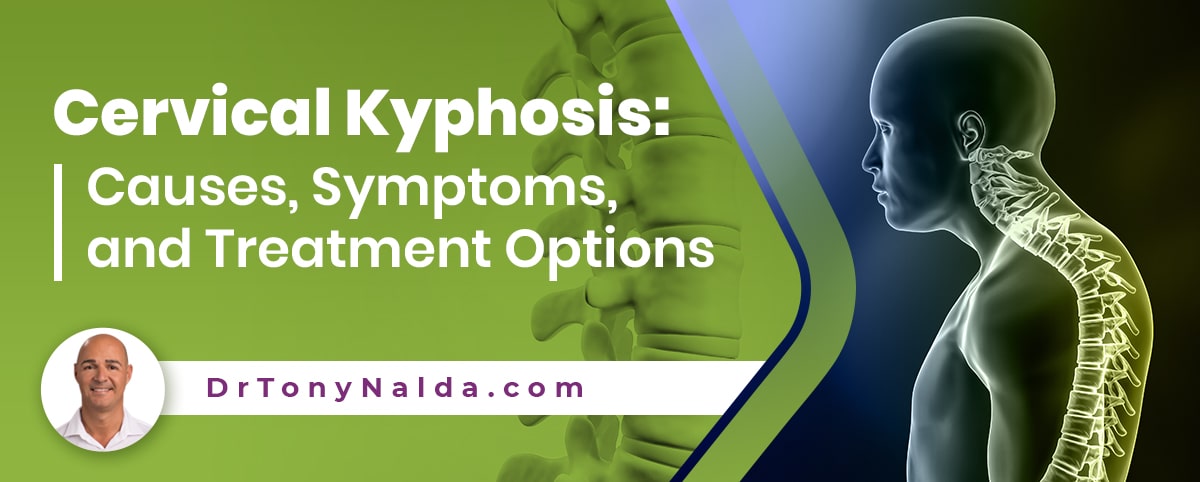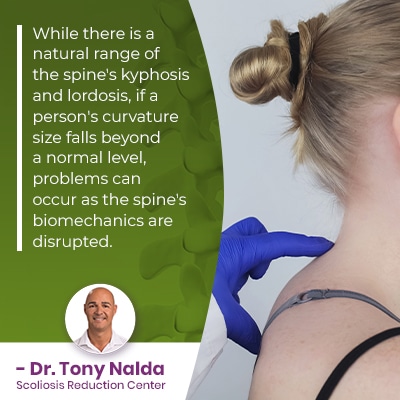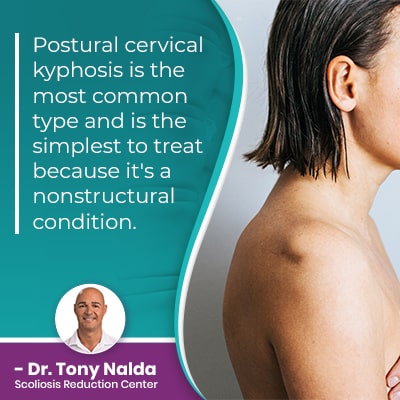Cervical Kyphosis: Causes, Symptoms, and Treatment Options

The cervical spine connects the brain to the rest of the body and consists of the spine's first seven vertebrae (C1 - C7). If the neck develops an unnatural spinal curve, it can cause a number of issues, such as difficulty supporting the weight of the head, and interfering with spinal canal nerves and central nervous system function.
If a person is diagnosed with cervical kyphosis, their neck has an excessive level of kyphosis. Kyphosis is a type of spinal curve that bends outwards, away from the body's center, in a reverse 'C' shape; causes, symptoms, and treatment options will be case-specific.
Before getting to the specifics of cervical kyphosis, let's start with some basic spinal anatomy.
Table of Contents
Spinal Anatomy
The spine is a key structure that facilitates flexible movement, the ability to stand upright and practice good posture, and works with the brain to form the body's central nervous system (CNS), which is why spinal conditions can affect the body in multiple ways.
If the spinal cord is compressed (exposed to uneven pressure), it can cause pain and interfere with brain-body communication.
The spine consists of vertebrae (bones) that are stacked on top of one another in a neutral and straight alignment, and there are three main spinal sections: cervical spine (neck), thoracic spine (middle/upper back), and the lumbar spine (lower back).
Adjacent vertebrae are separated by intervertebral discs that give the spine structure (vertebral bodies attach to the disc in between), combine forces to enable flexible movement, absorb stress incurred during activity, and act as the spine's shock absorbers.
If one or more spinal discs change shape, degenerative disc disease can be the cause, and this can cause a number of issues related to changes in the spine's structure, strength, alignment, muscle weakness, and can be associated with degenerative cervical kyphosis.
If a vertebral body shifts out of alignment with the rest of the spine, this will disrupt the section's natural and healthy curve, and can cause a sagittal deformity to develop.
The spine is naturally curved at each spinal section, and in order for the spine to functio optimally, it has to maintain its healthy curves and alignment.
This brings us to the different spinal curvature types: lordosis and kyphosis.
What is a Kyphotic Curve?
The reason a healthy spine looks like an 'S' from the sides, and appears flat when viewed from the front and/or back, is because of the curves that characterize each section of the spine.
The cervical and lumbar sections have lordotic curves that bend inwards, towards the body's center, in a standard 'C' shape, while the thoracic spine features a kyphotic curve that bends backwards in a reverse 'C' shape.
While there is a na tural range of the spine's kyphosis and lordosis, if a person's curvature size falls beyond a normal level, problems can occur as the spine's biomechanics are disrupted.
tural range of the spine's kyphosis and lordosis, if a person's curvature size falls beyond a normal level, problems can occur as the spine's biomechanics are disrupted.
A healthy range of kyphosis falls between 20 and 45 degrees, but what happens if the cervical spine loses its slight lordotic curve, and instead develops more kyphosis?
To have cervical kyphosis diagnosed, this means the neck's healthy lordosis has been disrupted by excessive kyphosis, often causing a pitched-forward type of posture.
While some cases of mild cervical kyphosis don't cause a lot of issues, it can cause forward head posture to develop, along with a number of other symptoms.
Symptoms of Cervical Kyphosis
Spinal conditions, in general, range widely in severity, and a kyphotic deformity is no exception, which is why the customization of effective treatment plans is necessary.
As such a highly-variable condition, no two cases will be the same, including experienced symptoms shaped by patient age, condition severity, and condition type.
Cervical kyphosis can also be referred to as military neck because of how it can affect the neck's appearance, due to the development of an unnatural forward curve that makes it straighter than it should be, as opposed to keeping its natural and healthy backward curve (lordosis).
That being said, there are some symptoms that are commonly associated with cervical spine kyphosis:
- An unnatural curve in the neck that's visible
- A pitched-forward posture
- Reduced range of motion in the neck
- Neck pain
- Neck stiffness
- Muscle weakness in the neck
If severe kyphosis is present and/or if the condition is left untreated to progress, symptoms tend to escalate and can include:
- Radiating pain due to nerve compression difficulties (pain/tingling/numbness)
- Reduced limb mobility
- Limb mobility bladder issues
- Bowel issues
So now that we've defined the spinal deformity, and explored some of its common, and severe, symptoms, let's move on to the different types of kyphosis as this leads us to causation.
Exaggerated Kyphotic Curve Causes
As is the case with many spinal conditions, there are multiple types based on different underlying causes, condition severity, and experienced symptoms.
As mentioned earlier, symptoms, treatment needs, and causation is case specific, and this is partially because there are different types of kyphosis; its three main forms are postural kyphosis, Scheuermann's kyphosis, and congenital kyphosis.
Postural Cervical Kyphosis
 Postural cervical kyphosis is the most common type and is the simplest to treat because it's a nonstructural condition.
Postural cervical kyphosis is the most common type and is the simplest to treat because it's a nonstructural condition.
When a spinal condition is structural, it means there is an abnormality within the spine itself, so no change in position or active effort to correct the cervical spine will work; with postural kyphosis, the unnatural spinal curve can be reduced and/or eliminated when the spine is placed in different positions.
Postural cervical kyphosis occurs mainly in adolescents and is caused by chronic poor posture such as slouching, not standing up straight, and spending too much time looking down at devices.
Over time, poor posture can cause the neck muscles and ligaments to become stretched and loose, meaning they are not providing enough cervical spine support, and good support is necessary for maintaining the spine's healthy curves/alignment.
The clinical implications of the neck's muscles and ligaments becoming stretched is that they can pull on the vertebrae, forcing them out of alignment and leading to cervical kyphosis diagnosed.
Treatment for Postural Cervical Kyphosis
Postural cervical kyphosis can be addressed with lifestyle guidance, postural correction, therapeutic exercises/stretches, designed by a professional physical therapist, to increase core strength so the cervical spine's surrounding muscles and ligaments are strong and supportive.
This condition form is more common in females, has a flexible curve, and as it's not structural, doesn't generally involve the need for pain relief and/or functional deficits.
Scheuermann's Kyphosis
Unlike postural kyphosis, Scheuermann's kyphosis is structural in nature, making it more problematic and complex to treat.
When the spine's vertebrae are healthy, they are rectangular in shape, and this allows them to be stacked on top of one another in a natural and healthy alignment, but in Scheuermann's kyphosis, bone malformation is an issue with one or more of the vertebral bodies having a triangle shape, causing them to wedge together, curve forward, and decrease the cervical spine's level of lordosis, replacing it with excessive kyphosis.
The condition is more common in males and is most commonly diagnosed in adolescence.
As the kyphotic curve is structural, it's rigid, and this is why changes in position can't improve the condition, as it can in postural spinal conditions.
Scheuermann's can cause neck pain that varies in severity; factors like patient age and condition severity factor into how painful the condition is.
In general, related neck pain increases during long periods of sitting, standing, or activity.
Treatment for Scheuermann's Cervical Kyphosis
When a condition is structural, treatment has to impact it primarily on a structural level, and here at the Scoliosis Reduction Center, I integrate multiple condition-specific treatment disciplines: chiropractic care, physical therapy, corrective bracing, and custom-prescribed home exercises to further stabilize the spine.
I want to help prevent severe cases developing so the need for invasive surgical treatment, such as spinal fusion, can be avoided.
I also want to relieve pressure on the spinal cord and spinal canal so the nerves housed within have enough space to function optimally.
When treated proactively, different disciplines can complement one another by reducing the abnormal curve structurally, increasing core strength for optimal spinal support, and improving cervical spine kyphosis symptoms related to nerve compression difficulties.
Corrective bracing can also be particularly effective on growing spines; a neck brace can help by pushing the spine into a corrective position, augmenting corrective results achieved through other disciplines.
So when it comes time to treat cervical kyphosis classified as Scheuermann's, it can be more complex to treat, but is treatable, especially when caught early and addressed proactively.
Congenital Cervical Kyphosis
In cases of congenital kyphosis, the spine has lost its cervical lordosis as the cervical vertebrae in the cervical spine are malformed.
Infants are born with congenital kyphosis as a malformed spine develops in utero, so a congenital kyphotic deformity is also structural in nature, making it complex to treat.
Treatment For Congenital Cervical Kyphosis
Infants born with the condition are likely to have it progress with growth and development; this is why being proactive with treatment is so important.
Congenital malformations within the spine suggest the likelihood of other areas/parts of the body being malformed, so these patients need to have a comprehensive physical exam and be monitored and assessed regularly.
Considering some of the challenges associated with young patients, treatment plans need to be modified to address patient age and so much growth yet to go through.
As cases of congenital kyphosis involve a malformed spine, it’s not uncommon for other areas of the body to be malformed, so these young patients need to be carefully examined (includes taking the patient's medical history), assessed, and monitored for noticeable signs of other bodily malformations.
Each case is unique, but treatment plans can include condition-specific chiropractic care, physical therapy, and in specific cases, casting and/or corrective bracing.
Conclusion
The neck is important; it has to support the weight of the head and connects the brain to the rest of the body.
If an unnatural spinal curvature develops in the cervical spine, military neck can become an issue, the spine is no longer in proper alignment, and the upper body has a noticeable forward tilt.
A neck problem can increase the natural rate of degenerative changes in the cervical spine and cause a lot of potential issues such as neck pain, neurologic deficits due to spinal cord compression, and postural deviation.
Kyphosis refers to the spine's backwards curvature, and if a diagnosis of cervical kyphosis is given, this means the neck has lost its natural lordosis, instead developing an excessive kyphotic curve.
An excessive curvature's tendency is to progress, particularly with growth, which is why proactive treatment is so important.
The three most common types of cervical kyphosis are postural, Scheuermann's, and congenital, and symptoms of cervical kyphosis will vary based on condition type; kyphosis that's postural features a flexible curve because it's not structural so doesn't commonly cause pain, and can be addressed with postural remodeling and physical therapy.
Structural conditions are more complex to treat, and this is the case in Scheuermann's cervical kyphosis and congenital cervical kyphosis which needs to be impacted, primarily, on a structural level through kyphosis specific chiropractic care.
Cervical kyphosis treated proactively means addressing the excessive cervical kyphosis in the neck by working towards improvement in cervical spine alignment, while increasing core strength to address any related muscle weakness so spinal support can be increased.
Dr. Tony Nalda
DOCTOR OF CHIROPRACTIC
After receiving an undergraduate degree in psychology and his Doctorate of Chiropractic from Life University, Dr. Nalda settled in Celebration, Florida and proceeded to build one of Central Florida’s most successful chiropractic clinics.
His experience with patients suffering from scoliosis, and the confusion and frustration they faced, led him to seek a specialty in scoliosis care. In 2006 he completed his Intensive Care Certification from CLEAR Institute, a leading scoliosis educational and certification center.
About Dr. Tony Nalda
 Ready to explore scoliosis treatment? Contact Us Now
Ready to explore scoliosis treatment? Contact Us Now





